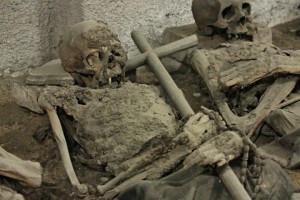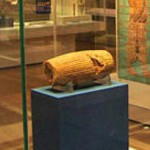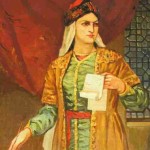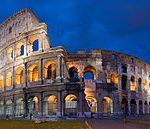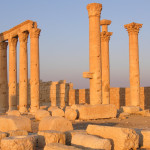Interview with Jaleh Niazi
From: Soheila Vahdati
If your child attended school in California, you may have noticed that they essentially have not learned anything about the Persian Empire as part of their school curriculum. All they have been taught is that there was a great, ancient civilization in Greece, and that the Greeks had an enemy whom they often warred with: the Persians! But why haven’t they learned about the Persian Empire as a great, ancient civilization in its own right, rather than defined as the enemy of Greeks?
This is a question that is currently being asked by a group of Iranian-American parents who are set to correct the school history books and give the Persian Empire and Iran’s historya rightful place in the history books. They are a handful of successful professionals who have made the time for grassroots activism in their busy daily lives. They have created a website HistoryAdvocates.com where you can find more about their concerns and activities.
I have had the pleasure to talk to one of the members, Jaleh Niazi, a pediatrician and mother of three, regarding the activism of a group of parents called, ‘History Advocates,’ on the matter.
Vahdati – Why do you think Greek history has a place in the school books, but Persian history does not?
Niazi – Your question is an excellent one with a complicated set of answers. Let me start by saying that the existence of a certain amount of pro-Greek or pro-Classical bias is to be expected. This is due to the fact that the civilizations of modern Europe claim the Greeks (and subsequently the Romans) as their direct ancestors, who were, in turn, the adversaries of the various Persian dynasties ruling western Asia from the sixth century BC to the advent of Islam. It is natural, therefore, to provide more air-time to one’s “ancestors” rather than to those who are viewed as their enemies. Another reason is that the vast majority of historical texts pertaining to the Greeks and the Persians during antiquity were written by Greek authors. These texts are more often than not expressions of a Greek-speaking national identity uniting against the ambitions of the considerably larger Persian Empire.
It is important to realize, however, that despite this antagonism the ancient Greeks found much to admire and to emulate in Persians and that there was much interaction between the cultures, with Greek soldiers fighting as mercenaries for the Persians, Greek doctors serving at the Persian court, and Greek women and men adopting the dress and other cultural artifacts of their neighbors to the East. Even among their enemies, the Persians in the form of the founder of the Persian Empire, Cyrus the Great, had their own fan club as evidenced by Cyropedia, a biography of his life, written by the Greek historian Xenophon in 4th century BC.
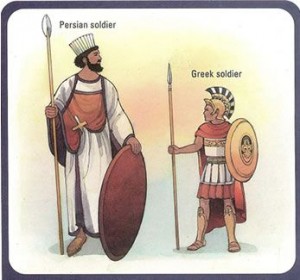 This image in the 6th grade history book depicts a Persian soldier as a giant in comparison to a Greek soldier.
This image in the 6th grade history book depicts a Persian soldier as a giant in comparison to a Greek soldier.
Vahdati – But it is the year 2014 now. Isn’t it time to update the view on Persian history?
Niazi – Well, it comes as a relief that modern scholarship has made great strides in providing a balanced investigation of the Persian Empire. Thanks to the work of archaeologists and other specialists, the many positive features of the empire founded by Cyrus the Great in the sixth century BC highlight the lasting contributions of the Persian Empire to civilization. According to the latest scholarship, the Persian Empire, which was the largest empire ever at its time, not only introduced new ideas of governance and cultural tolerance, but positively influenced many of the other civilizations, including those of the Greeks and the Romans. In the words of Professor John Lee(1) who on our groups behalf, is currently collaborating with the California State Board of Education (CSBE) on revisions to the Framework: “some may protest that there is not enough room in the curriculum to treat every ancient civilization. It is hardly possible, however, to argue that Achaemenid Persia should be excluded for lack of space. Achaemenid Persia played a central role in the development of the ancient world. For two centuries it was the largest empire the world had ever seen, spanning Egypt, Europe, the Near East, Central Asia, and South Asia. The Achaemenids created an enduring legacy that has influenced everything from ideas of rulership to the development of gardens and irrigation.” Professor Lee suggests that Alexander, whom we idealize as a great ruler, actually was heavily influenced by the Persian method of governance. According to Julian Raby(2) Cyrus, the founder of the Persian Empire is credited with freeing the Jews and allowing them to return to Jerusalem to build the Second Temple and “reshape” Judaism. In the words of Professor David Stronach (3) the world renowned expert on Iranian archaeology, Cyrus is the only ruler who is mentioned in laudatory terms in the Bible. According to the director of the British Museum, Professor Neil McGregor, “(Cyrus’s) method of governance as portrayed by the Greek writer Xenophon, in the book “Cyropaedia” was well known to our Founding Fathers, including Jefferson!” According to him, Jefferson kept multiple copies of the book and “referred to it regularly.”
Vahdati – Then why is it not reflected in the US school books? Why aren’t our children learning about a civilization that not only shaped great leaders of the past, but may have influenced the thinking of the Founding Fathers’ of the United States of America?
Niazi – As we explored this question with our children’s teachers, it became apparent that they had to adhere to strict guidelines from the CSBE, which limited their ability to teach updated information. These Content Standards were introduced as a bill and had to be ratified in the State Legislature. But why were the Standards so unrealistic and skewed against the Persians. According to Professor Lee, the Western colonialist in the nineteenth century in order to justify their exploits began to portray other civilizations in a negative light, including the Persian Civilization. Also, more recent finds and excavations were not available at the time the Content Standards were formulated. We are told that Achaemenid Persia (550-330 BC), as a separate topic, is now very commonly a subject of discussion at international meetings for the study of Greek History. In fact, there is a lag at this point between the latest scholarship and what is being taught in our schools.
Vahdati – How is the content of school history books defined, and how does it get modified or updated?
Niazi – If you look at the Content Standards for 6th grade, when ancient history is first introduced to our young students, there are particular civilizations/cultures that are required to be taught, namely, Mesopotamia, Egypt, Kush, Hebrew, Ancient Greece and Rome. Under the subsection, Persian Wars, in the Greek section, the students are to be briefly introduced to the Persian Empire. Unfortunately, that little exposure is fraught with misinformation. In the sixth grade history textbook of our children, “History Alive” 2004 edition*, a fictional letter is written by a Greek soldier to a loved one who is on his way to fight those “murderous invaders,” of course, referring to the Persians.
Vahdati – Is your goal then to have the Content Standards modified and updated?
Niazi – Of course. But there has been a freeze on the upgrade of the Content Standards since 1998. This freeze is proposed to be lifted by a current Senate Bill, SB-1057, which just passed in the Senate on May 29, 2014. While our ultimate goal is to change the Content Standards, currently we are working on the Framework.
Vahdati – What is Framework? Does it also need legislature approval?
Niazi – I should first explain the difference between Content Standards and Framework. The Content Standards is in outline form and is the absolute guideline which the Framework is based on. The Framework is a more detailed explanation of the Content Standards. It is currently being revised by CSBE based on a previous bill by Senator Hancock SB 1540, which became law in September of 2012.
With the revision of the Framework we have an opportunity to provide accurate inform- ation for the Persian subsection in the Greek section. Professor John Lee has already written a proposed revision for that section of the Framework.
If SB-1057 is passed, then the Content Standards change and there would be an opportunity to add Persian Civilization as a distinct civilization of the ancient world. Also, the upgrade for the current Framework will be stopped and a more fundamental change would be needed.
Vahdati – If this bill passes, then could we assume that your work is done?
Niazi – No. If SB-1057 passes, it is not guaranteed that the updated curriculum would contain the Persian Civilization as a distinct civilization, but the committee which most likely would be looking at this ( Instructional Quality Commission (IQC)), is already aware of our concerns . Our role is to continue to advocate for the latest scholarship of Ancient Persian and Modern Iranian History in the Content Standards, facilitating the process in anyway.
Vahdati – Now, after talking about the History Advocates’ concerns, let us talk about the actions. What specific steps are you taking to redress this issue?
Niazi – First, we contacted world renowned scholars in the field and obtained their support in redressing this issue. Such scholars would play an important role in providing the content for the revised curriculum.
We then wrote a letter to CSBE to voice our concerns, which has resulted in several meetings and ongoing collaboration. As a result, we are working with the CSBE to update the Framework for all the history content of grades K-12 as it pertains to Ancient Persian History all the way through modern Iranian History and Iranian-American demographics in California. A high-ranking CSBE representative has been open to our concerns and helpful in suggesting ways to make changes. He has also asked for expert opinion on reformulating the Framework and we have put him in contact with our scholars. Sometime in late June or early July, recommendations for the upgrade of the Framework will be accepted by CSBE which will be reviewed and finalized by September. We continue to serve as a liaison between the scholars, who have expressed an interest in updating the Framework and CSBE. The actual recommendations for revisions to the Framework to the CSBE will actually be made by us, the concerned parents, based on our scholars’ recommendations. Prof. John Lee, for example, has already provided us with specific recommendations for a particular part of the Framework.
We also met with TCI, the publishing company for the 6th grade history book, “History Alive”, with the help and attendance of a high-ranking official from the CSBE, and the CEO and senior officials of TCI. In that meeting, we voiced our objections to the slanderous language used to describe Persians and the lack of adequate coverage of the Persian Civilizations. The TCI officials apologized for the 2004 edition of the 6th grade history book and pointed to their 2011 edition, which has taken out the derogatory sentences, but still is lacking any substantial information on Persian Civilizations. This edition has not been recommended by the State yet, because it still has many deficiencies. TCI also promised to provide an updated supplementation on their website for teachers who opt to use it, but to my knowledge this hasn’t materialized yet.
We also have been in touch with our senator, Senator Loni Hancock, who not only has given us her full support, but has been extremely helpful in guiding us through the process. We continue to reach out to other representatives to educate them about the issue.
The CSBE tells us that School Districts are in charge of buying new books and supplemental material with funds allotted to them. Berkeley Unified School District has been extremely open to our criticism and has reportedly alerted all of their teachers to this fact. However, the infamous book, “History Alive!”2004 edition is still being taught in the district. It is unfortunate that the same 2004 edition is being used to teach our youngest daughter’s sixth grade class this year, despite BUSD (Berkeley Unified School District)’s awareness and concern about this issue.
I should add that on the side, we have taken many steps to gain support and awareness of this issue. We contacted the Getty Villa and the San Francisco Asian Art Museum and wrote a joint letter to the Superintendent of California Schools to inform him of the significant Cyrus Cylinder Tour that was happening this year in the United States.
Vahdati – How can other parents and Iranian-Americans in general join you and the grassroots movement?
Niazi – Of course. For the Iranian-Americans in California the unbalanced portrayal of ancient Persians is perplexing and at times demeaning, but for all of our children the lack of accurate history, especially in a global environment, can add to a lack of awareness and understanding of other cultures, especially with regards to the Middle East.
So with regards to your question of how to join this movement, we would say:
- Sign the petition, http://petitions.moveon.org/sign/ancient-persian-history and pass the word, asking your friends to sign it, too. Educate your friends and family about the importance of this bill. SB-1057, though important for our cause, is not limited to Persian Civilizations alone. It is a bill which is requiring regular updates to what is taught to our children based on the latest scholarship. This is an essential bill which will keep Californian students updated with the most recent findings and scholarship in history and social sciences.
- On our website, www.historyadvocates.com, there is a page “What You Can Do” where we have provided a template for other parents to write to the School Boards. There is also a least of Talking Points, and supplemental educational material to be shared with school districts.
- Like our Facebook page, “Ancient History Advocates” so we can inform you of the latest developments on the issue.
Should you have any specific suggestions or know of any scholars who would be interested in working with the CSBE please contact us at historyadvocates (at) gmail.com
Vahdati – Thank you for your efforts. I wish you all success.
Niazi – Thank you for giving me the opportunity to educate the public about our concerns.
* TCI’s (Teachers’Curriculum Institute) is a publisher, which is responsible for content and publishing of a significant portion of California school books.
** SB 1057
http://leginfo.legislature.ca.gov/faces/billNavClient.xhtml?bill_id=201320140SB1057
1- Professor John Lee teaches Ancient Greece, Achaemenid Persia, and History of Warfare at the University of California at Santa Barbara.
1- Julian Raby is the Director of the Freer Gallery of Art and Arthur M. Sackler Gallery of the Smithsonian.
2- Professor David Stronach is an Emeritus faculty of the Department of Near Eastern Studies at the University of California at Berkeley
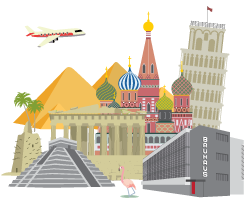 created a new program that offers increased access to the organization’s diverse World Heritage sites such as Avignon, France, the Giant’s Causeway in Northern Ireland and Peterhof Palace in St. Petersburg.The new partnership, announced last month (June 2014) and beginning with itineraries departing on or after Aug. 1, is expected to raise $1 million over six years by charging passengers $5 to $10 extra for World Heritage tours. The donations will be earmarked for preservation work by UNESCO.
created a new program that offers increased access to the organization’s diverse World Heritage sites such as Avignon, France, the Giant’s Causeway in Northern Ireland and Peterhof Palace in St. Petersburg.The new partnership, announced last month (June 2014) and beginning with itineraries departing on or after Aug. 1, is expected to raise $1 million over six years by charging passengers $5 to $10 extra for World Heritage tours. The donations will be earmarked for preservation work by UNESCO.
